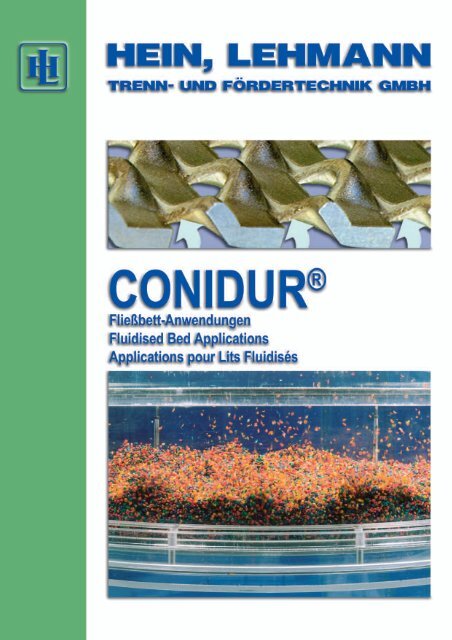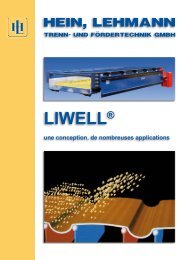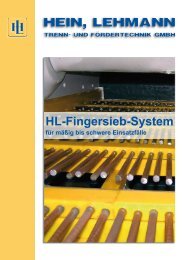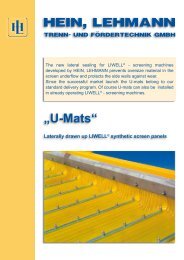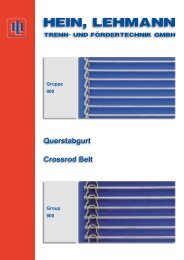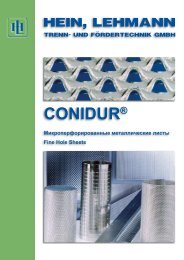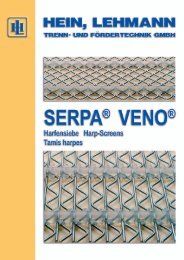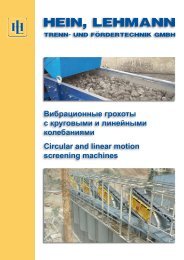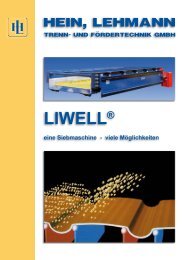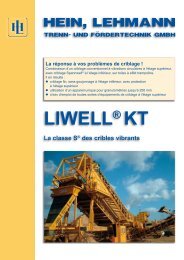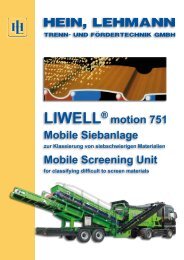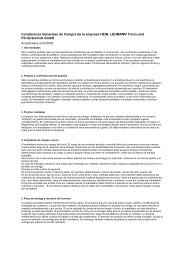CONIDUR® Fließbett - Hein, Lehmann Trenn- und Fördertechnik ...
CONIDUR® Fließbett - Hein, Lehmann Trenn- und Fördertechnik ...
CONIDUR® Fließbett - Hein, Lehmann Trenn- und Fördertechnik ...
Create successful ePaper yourself
Turn your PDF publications into a flip-book with our unique Google optimized e-Paper software.
Inhalt<br />
CONIDUR ® Werkstoffe<br />
CONIDUR ® -Feinlochbleche<br />
als Gas-Verteilerboden<br />
in <strong>Fließbett</strong>-Anlagen<br />
Auswahl der CONIDUR ® -<br />
Feinlochbleche<br />
Beispiel zur Auswahl eines<br />
CONIDUR ® -Feinlochbleches<br />
Druckverlustkurven<br />
Konischer CONIDUR ® Boden<br />
Lieferprogramm<br />
Fragebogen CONIDUR ® -<br />
<strong>Fließbett</strong>boden<br />
Contents<br />
CONIDUR ® Materials<br />
CONIDUR ® FineHole Sheets<br />
as gas distribution plates<br />
in fluidised bed applications<br />
Selection of CONIDUR ®<br />
Fine Hole Sheets<br />
Example for selection of a<br />
CONIDUR ® Fine Hole Sheet<br />
Pressure Drop Curves<br />
Conical CONIDUR ® deck<br />
Delivery program<br />
Questionnaire CONIDUR ®<br />
distribution deck<br />
Sommaire<br />
CONIDUR ® Nuances d’aciers<br />
Tôles Perforées CONIDUR ®<br />
à Petits Trous comme sole de<br />
distribution dans un lit fluidisé<br />
Sélection des Tôles Perforées<br />
CONIDUR ®<br />
Exemple de détermination d’une<br />
Tôle Perforée CONIDUR ®<br />
à Petits Trous<br />
Courbes de perte de charge<br />
Sole conique en CONIDUR ®<br />
Programme de livraison<br />
Questionnaire CONIDUR ®<br />
soles de fluidisations<br />
3<br />
4- 5<br />
6- 11<br />
12 - 14<br />
15 - 17<br />
18 - 29<br />
30<br />
31
Werkstoffe<br />
für CONIDUR ® -<br />
Lochbleche<br />
Produkte mit den unterschiedlichsten<br />
Feuchten, sowie<br />
physikalischen <strong>und</strong> chemischen<br />
Eigenschaften lassen sich auf<br />
CONIDUR ® -Lochblechen behandeln.<br />
Eine große Bedeutung kommt der<br />
Auswahl des richtigen Werkstoffes<br />
für das CONIDUR ® -<br />
Lochblech zu.<br />
4<br />
Informationen über Einsatzerfahrungen<br />
mit CONIDUR ® -<br />
Lochblechen bei höheren<br />
Temperaturen <strong>und</strong> korrosivem<br />
Angriff erteilen wir Ihnen gerne auf<br />
Anfrage.<br />
Die Tabelle zeigt die Werkstoffe,<br />
die am häufigsten Verwendung<br />
finden.<br />
Werkstoffbezeichnung<br />
Material standards<br />
Équivalence de normes<br />
Deutschland <strong>und</strong> Europa international: USA u.a.<br />
Germany and Europe international: USA and others<br />
Alemagne et Europe international: USA et autres<br />
Unter der Berücksichtigung<br />
von Ausgangsblechdicke <strong>und</strong><br />
geforderter Lochweite sind<br />
CONIDUR ® -Lochbleche auch in<br />
folgenden Werkstoffen herstellbar:<br />
• Duplex-Stahl (z.B. 1.4462)<br />
• weitere Nickellegierungen<br />
z.B. Hastelloy C-22, C-276,<br />
Inconel 600 / 625<br />
• Aluminium<br />
• Silber<br />
• Tantal<br />
• Niob<br />
• u.a.<br />
Die Möglichkeit andere Werkstoffe<br />
zu verwenden, prüfen wir<br />
auf Anfrage gerne.<br />
Werkstoff-Nr. Kurzbezeichnung AISI/SAE/ASTM<br />
UNS-No. common name<br />
EN 10027 T.2 EN 10027 T.1<br />
1.4016 X6Cr17 S43000 430<br />
1.4301 X5CrNi18-10 S30400 304<br />
1.4306 X2CrNi19-11 S30403 304L<br />
1.4541 X6CrNiTi18-10 S32100 321<br />
1.4401 X5CrNiMo17-12-2 S31600 316<br />
1.4404 X2CrNiMo17-12-2 S31603 316L<br />
1.4571 X6CrNiMo17-12-2 S31635 316Ti<br />
1.4539 X1NiCrMoCu25-20-5 N08904 “904L“<br />
2.4360 NiCu30Fe N04400 “Monel 400“<br />
2.4610 NiMo16Cr16Ti N06455 “Hastelloy C-4“<br />
(3.7025) Rein - Titan, Ti 99,5 R50250 Ti Grade 1.
Materials for<br />
CONIDUR ® -<br />
Hole Sheets<br />
Products with different humidities,<br />
physical and chemical properties<br />
can be processed on CONIDUR ® -<br />
Hole Sheets.<br />
It is important to select the right<br />
material and finish on the<br />
CONIDUR ® -Hole Sheet to suit<br />
each particular application.<br />
Information about experiences<br />
with CONIDUR ® -Hole Sheets at<br />
high temperatures and on<br />
corrosive applications are<br />
available on request.<br />
The table on page 4 out-lines<br />
materials which are mostly used<br />
dependent on initial sheet<br />
thickness and required hole size.<br />
CONIDUR ® -Hole Sheets can also<br />
be made out of the following<br />
materials:<br />
• duplex steel (i. e. 1.4462),<br />
• compositions of nickel<br />
i.e. hastelloy C-22, C-276,<br />
inconel 600/625<br />
• aluminium<br />
• silver<br />
• tantalum<br />
• niob<br />
• and others<br />
Availability of other materials than<br />
those listed can be determined<br />
upon request.<br />
Nuances d’aciers<br />
pour les Tôles<br />
CONIDUR ®<br />
Les produits les plus différents du<br />
point de vue de l’humidité, des<br />
propriétés physiques et chimiques<br />
peuvent être traités par les Tôles<br />
CONIDUR ® .<br />
Le bon choix de la nuance d’acier<br />
de la CONIDUR ® est important de<br />
manière à correspondre à chaque<br />
cas.<br />
Des informations sur notre<br />
expérience dans l’utilisation des<br />
Tôles CONIDUR ® en milieu<br />
corrosif et températures extrêmes<br />
sont à votre disposition sur<br />
demande.<br />
Le tableau, page 4, indique les<br />
nuances d’aciers les plus utilisés<br />
en accord avec l’épaisseur initiale<br />
de la tôle CONIDUR ® et la taille<br />
de l’ouverture désirée.<br />
Les aciers ci-dessous peuvent<br />
également être utilisés pour la<br />
réalisation des Tôles CONIDUR ® .<br />
• aciers duplex (ex. 1.4462),<br />
• des alliages spéciaux<br />
ex. Hastelloy C-22, C-276,<br />
Inconel 600 / 625<br />
• aluminium<br />
• argent<br />
• tantale<br />
• niob<br />
• autres<br />
La possibilité d’utilisation d’autres<br />
nuances d’acier sera déterminée<br />
en fonction du cas particulier.<br />
Mit der richtigen Blechausführung zum Ziel<br />
Achieve the goal with the right sheet specification<br />
Arriver au but avec la bonne spécification de tôle<br />
5
CONIDUR ® -Feinlochblech als<br />
Anströmboden in einer <strong>Fließbett</strong>anlage.<br />
Je nach Anwendung kann die<br />
Bodenfläche mehrere m² betragen;<br />
in Einzelfällen bis 60 m².<br />
6<br />
CONIDUR ® Fine Hole Sheet as<br />
distribution deck in a fluidised bed<br />
unit.<br />
Depending on application the area<br />
can run to several m²; in particular<br />
cases up to 60 m².<br />
Tôle Perforée CONIDUR ® à Petits<br />
Trous comme sole de distribution<br />
dans un lit fluidisé.<br />
Selon l’application, les soles peuvent<br />
avoir des surface de travail<br />
de plusieurs m², jusqu’à 60 m².
In immer stärkerem Maße werden<br />
Schüttgüter in <strong>Fließbett</strong>-Anlagen<br />
thermisch behandelt.<br />
Der Gr<strong>und</strong> ist in der hohen Wirtschaftlichkeit<br />
infolge des intensiven<br />
Wärme- bzw. Stoffaustausches<br />
zwischen Feststoff <strong>und</strong><br />
fluidem Medium zu sehen.<br />
Ein wesentlicher Bestandteil einer<br />
<strong>Fließbett</strong>-Anlage ist der CONI-<br />
DUR ® -Gas-Verteilerboden.<br />
Der nach Druckverlust spezifizierte<br />
Boden verteilt das fluide<br />
Medium gleichmäßig an den<br />
Feststoff weiter, ohne dass der<br />
Feststoff durch den porösen<br />
Anströmboden rieselt oder diesen<br />
verstopft, wenn kein Gasdruck<br />
unter dem Boden ansteht.<br />
Die gleichmäßige Verteilung des<br />
fluiden Mediums erreicht man<br />
durch einen Mindestdruck unter<br />
dem Anströmboden in Abhängigkeit<br />
von den Produktdaten <strong>und</strong> der<br />
Schütthöhe in der Anlage.<br />
Alle CONIDUR ® Feinlochbleche<br />
für <strong>Fließbett</strong>anlagen sind:<br />
• gerichtet<br />
• gewalzt<br />
• elektrolytisch entgratet<br />
<strong>und</strong> poliert<br />
Der CONIDUR ® Boden erfüllt aber<br />
noch weitere Anforderungen, die<br />
zu einem reibungslosen Betrieb<br />
der <strong>Fließbett</strong>-Anlage führen.<br />
CONIDUR ® -Feinlochbleche<br />
als Gas-Verteilerböden in <strong>Fließbett</strong>-Anlagen<br />
Trocknen, Kühlen, Coaten, Agglomerieren<br />
Die wichtigsten hiervon sind:<br />
• Anpassung des Staudrucks<br />
an die Verfahrensparameter<br />
• Stabile CONIDUR ® Blechausführung,<br />
auch bei<br />
feinsten Lochungen<br />
• Gute Anpassungsfähigkeit<br />
an die jeweilige Trocknerkonstruktion<br />
• Hohe mech. Belastbarkeit<br />
bei entsprechender<br />
Unterstützung<br />
• Einsatz im Bereich von<br />
Betriebstemperaturen ≥ 500 °C<br />
• Stabiles <strong>Fließbett</strong> durch<br />
gleichmäßige Luftverteilung<br />
• Freie Öffnungen durch hohe<br />
Gas-Geschwindigkeiten in<br />
den düsenartigen, konischen<br />
Lochungen<br />
• Änderung der Produktförderrichtung<br />
durch die gerichtete<br />
Luftströmung<br />
• Entleeren des Trockners ohne<br />
zusätzliche dynamische<br />
Antriebskräfte<br />
• Passive Oberfläche<br />
durch elektrolytische<br />
Nachbehandlung der Böden,<br />
daher nahezu kein Anbacken<br />
• Ausgezeichnete<br />
Reinigungsmöglichkeit auf<br />
mechanischem, chemischem,<br />
pneumatischem oder<br />
hydrodynamischem Wege.<br />
Die Erfüllung dieser Anforderungen<br />
führt dazu, dass in vielen<br />
Fällen mit dem CONIDUR ® Feinlochblech<br />
eine Leistungssteigerung<br />
von <strong>Fließbett</strong>-Anlagen<br />
erreicht werden kann bzw. ein<br />
störungsfreier Betrieb ermöglicht<br />
wird.<br />
Nachfolgend aufgeführte Produkte<br />
werden auf einem<br />
CONIDUR ® Feinlochblech thermisch<br />
behandelt:<br />
1. Chemie-Industrie<br />
• organische Säuren<br />
• Farben<br />
• Salze<br />
• Düngemittel<br />
• Schädlingsbekämpfungsmittel<br />
• Kunststoffe<br />
• Waschmittelzusätze<br />
2. Nahrungsmittel-Industrie<br />
• Kaffee<br />
• Kakao<br />
• Tee<br />
• Zucker<br />
• Milchpulver<br />
• Getreide<br />
• Gemüse<br />
• Kindernahrungsmittel<br />
• Gelatine<br />
• Lebensmittel-Instantprodukte<br />
3. Allg. Aufbereitungstechnik<br />
• Kohle<br />
• Quarzsand<br />
• Formsand<br />
Alle CONIDUR ® -Feinlochbleche<br />
für Anwendungen in der<br />
Wirbelschicht-Technik werden vor<br />
Auslieferung in einer Messeinrichtung<br />
auf den geforderten<br />
Druckverlust in Abhängigkeit der<br />
Anströmgeschwindigkeit geprüft.<br />
Die Luftrichtung wird mit einem<br />
richtungsweisenden Aufdruck<br />
(s. Abb.) auf der Produktseite des<br />
CONIDUR ® -Lochbleches gekennzeichnet.<br />
Luftströmung<br />
7
Intensiver Wärme- <strong>und</strong> Stoffaustausch<br />
in der <strong>Fließbett</strong>schicht<br />
bei Einsatz von CONIDUR ® Feinlochblechen<br />
Die horizontale Luftrichtungskomponente<br />
ermöglicht die Produktförderung<br />
in eine Richtung<br />
<strong>und</strong> unterstützt dabei den Entleerungsvorgang.<br />
8<br />
Intensive heat and material<br />
exchange in the fluid bed while<br />
using CONIDUR ® Fine Hole<br />
Sheets<br />
Horizontal air flow enables<br />
conveying of the product and<br />
supports the discharge at the<br />
same time.<br />
Echange thermique intensif et<br />
circulation du produit dans un lit<br />
fluidisé par l’utilisation des Tôles<br />
Perforées CONIDUR ® à Petits<br />
Trous<br />
La composante horizontale<br />
permet le transport du produit et<br />
facilite également sa vidange<br />
éventuelle.
An increasing number of bulk<br />
materials are thermally treated in<br />
fluidised bed units.<br />
One important reason for this is<br />
the high economic efficiency<br />
resulting from the intensive heat<br />
and material exchange between<br />
solid material and fluid medium.<br />
An essential component of the<br />
fluid bed installation is the<br />
CONIDUR ® Gas Distribution<br />
Plate.<br />
The distribution plate which is<br />
specified by the pressure drop,<br />
distributes the fluid medium as<br />
evenly to the solid material<br />
preventing that the solid material<br />
flows through the porous<br />
distributor plate or clogging it, if<br />
there is no gas pressure <strong>und</strong>er the<br />
plate.<br />
The even distribution of the fluid<br />
medium is obtained by a minimum<br />
pressure <strong>und</strong>er the distribution<br />
plate dependent on product data<br />
and dumping height in the<br />
installation.<br />
All CONIDUR ® Fine Hole Sheets<br />
for fluidised bed units are:<br />
• levelled<br />
• rolled<br />
• electrolytically de-burred<br />
and polished<br />
Moreover the CONIDUR ®<br />
Distribution Plate fulfil further<br />
requirements enabling smooth<br />
work of the installation.<br />
CONIDUR ® -Fine Hole Sheets<br />
as gas distribution deck in fluidised bed units<br />
drying, cooling, coating, agglomizing<br />
The most important are:<br />
• Adaptability of pressure head<br />
to process parameters<br />
• Strong CONIDUR ® Plates<br />
with finest perforations<br />
• Good adaptability to the<br />
respective dryer construction<br />
• High mechanical loading<br />
capacity with suitable support<br />
• Applicable to working<br />
conditions ≥ 500 °C<br />
• A stabil fluid bed due to<br />
an even air distribution<br />
• Jet-shaped conical holes<br />
produce a sharp air flow<br />
which keeps the openings free<br />
• Change of conveying direction<br />
by guided air-flow<br />
• Discharge of the dryer without<br />
additional dynamic driving<br />
power<br />
• Passive surface due to<br />
electrolytically treatment<br />
of the plates, therefore<br />
• Hardly any adhesion<br />
• Excellent cleaning facilities<br />
by mechanical, chemical,<br />
pneumatically and<br />
hydrodynamic means<br />
By meeting these requirements the<br />
application of CONIDUR ® Fine<br />
Hole Sheets enables in many<br />
cases an increase of capacity of<br />
the fluidised beds and a troublefree<br />
operation.<br />
The following products have been<br />
handled in fluidised bed units so<br />
far:<br />
1. Chemical Industry<br />
• organic acids<br />
• paints<br />
• salts<br />
• fertilizers<br />
• insecticides<br />
• synthetics<br />
• detergent additives<br />
2. Food Industry<br />
• coffee<br />
• cocoa<br />
• tea<br />
• sugar<br />
• milk powder<br />
• cereals<br />
• vegetables<br />
• baby food<br />
• gelatine<br />
• instant products for food stuff<br />
3. General Processing<br />
• coal<br />
• quarz sand<br />
• mould sand<br />
All CONIDUR ® Fine Hole Sheets<br />
to be applied for fluidisation have<br />
to pass before delivery a special<br />
test to check up the pressure drop<br />
in dependence on the afflux<br />
velocity.<br />
The direction of the air flow is<br />
indicated by the arrow (see below)<br />
marked on the product side of the<br />
CONIDUR ® Fine Hole Sheet.<br />
Air Flow<br />
9
CONIDUR ® -<br />
Feinlochbleche<br />
als Anströmböden<br />
im <strong>Fließbett</strong><br />
Die Strömungsrichtung des<br />
Gases über dem Verteilerboden<br />
kann durch unterschiedliche Zusammensetzung<br />
der CONIDUR ® -<br />
Lochbleche bestimmt werden.<br />
Dabei können auch Bleche mit<br />
unterschiedlichen Druckverlusten<br />
kombiniert werden.<br />
Dieses Schaubild zeigt beispielhaft<br />
verschiedene Ausführungen.<br />
10<br />
CONIDUR ® -<br />
Fine Hole Sheets<br />
as Distribution Decks<br />
in Fluidised Beds<br />
The direction of the airflow over<br />
the distribution plate can be<br />
determined by arranging the<br />
CONIDUR ® Pierced Sheet in<br />
different ways.<br />
It is also possible to combine<br />
sheets with different pressure<br />
drops.<br />
This picture shows various<br />
arrangements.<br />
Tôles Perforées<br />
CONIDUR ®<br />
comme soles de distribution<br />
pour des lits fluidisés<br />
Selon la disposition des tôles<br />
CONIDUR ® constituant la sole de<br />
distribution, on peut déterminer le<br />
sens du flux.<br />
On peut également combiner des<br />
tôles CONIDUR ® ayant des pertes<br />
de charge différentes.<br />
Les photos montrent différentes<br />
combinaisons.
Tôles Perforées CONIDUR ® à Petit Trous<br />
comme sole de distribution<br />
pour le séchage, le refroidissement, l’enrobage et l’agglomération<br />
De plus en plus de produits en<br />
vrac sont destinés à être traités<br />
par des unités de séchage à lits<br />
fluidisés<br />
La principale raison réside dans<br />
la grande efficacité que procure<br />
cet échange thermique direct et<br />
intensif.<br />
L’élément le plus important d’un<br />
lit fluidisé est la sole de<br />
distribution réalisée en tôle<br />
CONIDUR ® .<br />
En fonction de la perte de charge<br />
spécifiée la CONIDUR ® répartit<br />
de façon homogène le flux d’air<br />
sur toute la surface de la sole. La<br />
forme de la perforation empêche<br />
les pertes à travers les trous et<br />
le colmatage en cas de non<br />
présence de flux sous la sole.<br />
La distribution homogène du flux<br />
est obtenue par une pression<br />
adéquate sous la sole de<br />
distribution.<br />
Celle-ci est dépendante des<br />
caractéristiques du produit et de<br />
l’épaisseur de couche désirée .<br />
Toutes les Tôles Perforées<br />
CONIDUR à Petit Trous pour<br />
l’application lits fluidisés sont<br />
• planées<br />
• laminées<br />
• ébavurées et polies<br />
électrolytiquement<br />
De plus la sole de distribution a<br />
d’autres propriétés qui permettent<br />
un travail régulier et sans à<br />
coups.<br />
Les propriétés les plus importantes<br />
sont:<br />
• L’adaptation de la pression aux<br />
caractéristiques du procédé.<br />
• Bonne résistance mécanique<br />
de la tôle même aux perforations<br />
très fines.<br />
• De bonnes possibilités<br />
d’adaptation aux différents types<br />
de conception des sécheurs.<br />
• Capacité de charge élevée avec<br />
une structure correspondante.<br />
• Utilisation possible avec<br />
des températures ≥ 500 °C<br />
• Lit de fluidisation stable par<br />
une répartition régulière de l’air<br />
• Perforations toujours ouvertes<br />
grâce à la vitesse rapide du<br />
flux à travers les ouvertures<br />
coniques.<br />
• Changement simple du sens<br />
du flux grâce au jet dirigé.<br />
• Vidange du sécheur sans<br />
activation de puissance<br />
supplémentaire.<br />
• Polissage par électrolyse<br />
limitant le risque de colmatage.<br />
• Excellentes possibilités de<br />
nettoyage par procédés<br />
mécaniques, chimiques<br />
ou hydropneumatiques.<br />
L’ensemble de ces propriétés<br />
assure un meilleur rendement du<br />
sécheur ainsi qu’un fonctionnement<br />
avec un minimum de pannes.<br />
Les produits suivants ont déjà été<br />
traités dans un sécheur à lit<br />
fluidisé:<br />
1. Industrie Chimique<br />
• acides organiques<br />
• colorants<br />
• sels<br />
• compost<br />
• insecticide<br />
• plastiques<br />
• produits cosmétiques<br />
2. Industrie Alimentaire<br />
• café<br />
• cacao<br />
• thé<br />
• sucre<br />
• lait en poudre<br />
• céréales<br />
• légumes<br />
• aliments pour bébés<br />
• gélatine<br />
• produits lyophilisés<br />
3. Autre Applications<br />
• charbon<br />
• quartz<br />
• sables<br />
Toutes nos Tôles Perforées<br />
CONIDUR ® utilisées en fluidisation<br />
sont soumises à un contrôle<br />
final de vérification de la perte de<br />
charge en fonction de la vitesse.<br />
Le sens du flux est signalé par<br />
une flèche sur la face de travail<br />
(voir photo) de la tôle CONIDUR ® .<br />
Courant d‘air<br />
11
Betriebs- Korrektur-<br />
Temperatur °C Faktor „f“<br />
12<br />
Auswahl der<br />
CONIDUR ® -<br />
Feinlochbleche<br />
CONIDUR ® -Feinlochbleche<br />
können mit verschiedensten<br />
Lochgrößen gefertigt werden.<br />
Daraus resultieren unterschiedliche<br />
Druckverluste bei einer<br />
entsprechenden Anströmgeschwindigkeit.<br />
Die Druckverlustkurven einiger<br />
Bleche finden Sie auf den Seiten<br />
18 - 29. Die Werte beziehen sich<br />
auf Luft von 20 °C, 1010 hPa <strong>und</strong><br />
60 % relativer Luftfeuchtigkeit.<br />
Maßgebend für die richtige<br />
Auswahl eines CONIDUR ® -Feinlochbleches<br />
sind die Verfahrensparameter:<br />
• Volumenstrom<br />
bei Betriebstemperatur<br />
• zugehörig spezifizierter<br />
Druckverlust des CONIDUR ® -<br />
Feinlochbleches.<br />
Der spezifische Druckverlust<br />
(Druckdifferenz zwischen An- <strong>und</strong><br />
Abströmseite) des CONIDUR ® -<br />
Feinlochbleches ist abhängig vom<br />
Verfahren <strong>und</strong> vom Produkt.<br />
Außerdem ist die Fließfähigkeit<br />
des Produktes zu berücksichtigen.<br />
Aufgr<strong>und</strong> der speziellen Herstellungsart<br />
sowie zusätzlicher<br />
Oberflächen-Nachbehandlungen<br />
der CONIDUR ® -Feinlochbleche<br />
sollte eine Druckverlust-Toleranz<br />
von ±25% in Betracht gezogen<br />
werden.<br />
Die Strömungsgeschwindigkeit<br />
über dem Wirbelbett muss kleiner<br />
sein als die Sinkgeschwindigkeit<br />
der kleinsten Teilchen im Schüttelgutverband,<br />
da sonst zuviel<br />
Produkt durch den Gasstrom mit<br />
gerissen <strong>und</strong> in einem Filter oder<br />
Zyklon ohne thermische Behandlung<br />
zurückgewonnen werden<br />
muss.<br />
Die Lochgröße kann durchaus<br />
größer sein als die kleinsten<br />
Produktteilchen, da durch<br />
Brückenbildung oberhalb des<br />
Loches ein Durchrieseln weitgehend<br />
verhindert wird, auch<br />
wenn kein Gasdruck unter dem<br />
Boden ansteht. Ausgenommen<br />
von dieser Regel sind dynamisch<br />
angetriebene Trockner.<br />
Beträgt die Temperatur der<br />
anströmenden Luft nicht 20 °C, so<br />
muss der Druckverlust „∆p“<br />
mittels der Korrekturzahl „f“<br />
umgerechnet werden, um den<br />
Druckverlust des CONIDUR ® -<br />
Feinlochbleches „∆p“ bei 20 °C zu<br />
erhalten.<br />
Die Korrekturzahl „f“ ergibt sich<br />
aus dem Verhältnis des Gas-<br />
Dichtewertes ϕ bei 20 °C zum<br />
Dichtewert ϕ bei der Temperatur<br />
t °C des anströmenden Mediums<br />
bei konstantem Druck.<br />
Mit steigender Temperatur sinkt<br />
<strong>und</strong> mit fallender Temperatur<br />
steigt bei konstanter Anströmgeschwindigkeit<br />
der Druckverlust<br />
(∆p 1 ).<br />
Unser Fragebogen auf Seite 33/<br />
34 hilft bei der Auswahl des<br />
CONIDUR ® - Feinlochbleches.
Selection of<br />
CONIDUR ®<br />
Fine Hole Sheets<br />
CONIDUR ® Fine Hole Sheets can<br />
be fabricated in a great variety of<br />
hole sizes. This results in different<br />
pressure drops with according<br />
afflux velocity.<br />
On page 18 - 29 you can see<br />
pressure drop curves of some<br />
sheets. The values are based on<br />
an air temperature of 20 °C and<br />
1010 hPa as well as 60 % relative<br />
humidity of air.<br />
Selection of the right CONIDUR ®<br />
Fine Hole Sheet is decisively<br />
determined by process parameters:<br />
• gas volume at operating<br />
temperature<br />
• corresponding specified<br />
pressure drop of the<br />
CONIDUR ® Fine Hole Sheet.<br />
The specified pressure drop<br />
(difference in pressure between<br />
approach side and working side)<br />
of the CONIDUR ® Fine Hole<br />
Sheet depends on process and<br />
product. Flowability of the product<br />
has also to be considered.<br />
Because of the special<br />
manufacturing method and<br />
additional surface treatment of<br />
CONIDUR ® Fine Hole Sheet a<br />
pressure drop of ± 25% should be<br />
taken into consideration.<br />
The gas velocity over the<br />
distributor plate is important. It<br />
has to be smaller than the sinking<br />
speed of the smallest particles in<br />
the fluidised product bed, as<br />
otherwise too much of the product<br />
will be carried along by the gas<br />
flow and has to be recovered<br />
<strong>und</strong>ried or uncooled in a filter or<br />
cyclone.<br />
The hole size can, of course, be<br />
larger than the smallest product<br />
particle, as trickling through is<br />
largely prevented by rapid gapbridging<br />
over the openings, even<br />
if there is no gas pressure <strong>und</strong>er<br />
the plate. This rule does not apply<br />
to vibratory dryers.<br />
If the temperature of the afflux<br />
velocity does not correspond to<br />
20 °C, the pressure drop „∆p“ has<br />
to be converted with the correction<br />
factor „f“ to achieve the<br />
corresponding pressure drop of<br />
the CONIDUR ® Fine Hole Sheet<br />
„∆p“ at 20 °C.<br />
The conversion factor „f“ results<br />
from the ratio between gas<br />
density value ϕ at 20 °C and<br />
density value ϕ at operating<br />
temperature t °C of the approaching<br />
fluid medium at constant<br />
pressure. At constant approach<br />
velocity the pressure drop (∆p 1 )<br />
decreases with increasing<br />
temperature and increases with<br />
falling temperature.<br />
Our questionaire on page 33/34<br />
gives a support on selection of the<br />
CONIDUR ® Fine Hole Sheet. Operating Correction<br />
Temperature °C Factor „f“<br />
13
température facteur de<br />
de travail (°C) correction (f)<br />
14<br />
Sélection<br />
des Tôles Perforées<br />
CONIDUR ®<br />
Les Tôles Perforées CONIDUR ®<br />
à petit trous peuvent être<br />
exécutées avec des perforations<br />
différentes. Des pertes de charge<br />
souhaitées sont obtenues en<br />
fonction de la vitesse de passage<br />
du flux.<br />
Différentes courbes de pertes de<br />
charges en fonction de l’épaisseur<br />
et de la perforation se trouvent<br />
dans les pages 18 - 29. Les<br />
valeurs indiquées se réfèrent à<br />
une température d’air de 20 °C,<br />
1010 hPa de pression et un taux<br />
d’ humidité relatif de 60%.<br />
Les paramètres de procédés pour<br />
la détermination de la Tôle<br />
Perforée CONIDUR ® adéquate<br />
sont:<br />
• Le volume d’air nécessaire<br />
à la température de travail<br />
• La perte de charge requise<br />
de la Tôle Perforée CONIDUR ®<br />
La perte de charge requise de la<br />
Tôle Perforée CONIDUR ®<br />
(différence de pression entre les<br />
2 cotés de la tôle) dépend du<br />
procédé et du produit.<br />
Les propriétés de fluidisation sont<br />
également déterminantes.<br />
Le mode particulier de fabrication<br />
et les traitements de surface<br />
additionnels limitent la tolérance<br />
sur la perte de charge à ± 25%.<br />
La vitesse de passage d’air à<br />
travers la sole doit être inférieure<br />
à la vitesse de chute des plus<br />
petites particules du produit.<br />
Autrement le produit est entraîné<br />
par le courant du flux et sera<br />
récupéré non séché et non refroidi<br />
dans le filtre ou le cyclone.<br />
La dimension de la perforation<br />
peut-être supérieure aux plus<br />
fines particules de produit car des<br />
: « ponts de produits » empêchent<br />
le passage à travers les<br />
ouvertures même en l’absence<br />
de flux sous la sole. Cela ne<br />
s’applique pas cependant aux<br />
sécheurs dynamiques.<br />
Pour le calcul des pertes de<br />
charge à des températures<br />
différentes de 20°C, il faut<br />
appliquer un coefficient de<br />
correction « f » qui tient compte<br />
de la différence de densité du flux.<br />
Ce facteur «f» est le résultat du<br />
rapport des deux densités du gaz<br />
ϕ à 20 °C sur densité ϕ à<br />
température t °C du flux avec une<br />
pression constant. A vitesse<br />
constante la perte de charge ∆p 1<br />
diminue si la température<br />
augmente et inversement.<br />
Notre questionaire à page 33/34<br />
voud aidera dans le choix des<br />
Tôles Perforées CONIDUR ® à<br />
Petit Trous.
Beispiel zur<br />
Auswahl eines<br />
CONIDUR ® -<br />
Feinlochbleches<br />
Gegeben:<br />
Anströmfläche A = 16 m²<br />
Volumenstrom<br />
•<br />
V = 14000 m³/h<br />
Temperatur der<br />
anströmenden Luft<br />
t 1 = 110 °C<br />
max. zulässige<br />
Lochung L w = 0,5 mm<br />
spezifizierter<br />
Druckverlust ∆p = 600-800 Pa<br />
1<br />
Aus dem Volumenstrom (m³/h)<br />
<strong>und</strong> der Anströmfläche A (m²) ergibt<br />
sich die Anströmgeschwindigkeit v<br />
unter dem CONIDUR ® •<br />
V<br />
- Feinlochblech.<br />
v =<br />
•<br />
V<br />
————<br />
A * 3600<br />
(m/s)<br />
14000<br />
v = ————— = 0,243 m/s<br />
16 * 3600<br />
Mittels der Anströmgeschwindigkeit<br />
v läßt sich anhand der<br />
Druckverlustkurven, abhängig vom<br />
erforderlichen Druckverlust ∆p 1 <strong>und</strong><br />
der zulässigen Lochung ein<br />
entsprechendes Feinlochblech<br />
auswählen.<br />
Da den Druckverlustkurven eine<br />
Lufttemperatur von 20 °C zugr<strong>und</strong>e<br />
liegt, muss der Wert ∆p 1 (700)<br />
Pa) mittels der Korrekturzahl „f“<br />
umgerechnet werden<br />
(„f“ für 110 °C = 0,763).<br />
∆p 1 = ∆p * f<br />
700<br />
∆p = ———<br />
0,763<br />
∆p = 917 Pa<br />
Das CONIDUR ® Feinlochblech hat<br />
bei 20 °C Lufttemperatur <strong>und</strong> 0,243<br />
m/s Anströmgeschwindigkeit einen<br />
Druckverlust von ∆p 917 Pa.<br />
Im Einsatzfall bei 110 °C Lufttemperatur<br />
ergibt sich der geforderter<br />
Druckverlust von ∆p 1 = 700 Pa.<br />
Gewählt:<br />
CONIDUR ® -Feinlochblech Nr. 38,<br />
Seite 21<br />
Example for<br />
selection of a<br />
CONIDUR ®<br />
Fine Hole Sheet<br />
Given:<br />
working surface A = 16 m²<br />
volume of<br />
•<br />
approaching air V = 14000 m³/h<br />
temperature of<br />
approaching air t 1 = 110 °C<br />
max. permissible<br />
hole size L w = 0,5 mm<br />
Specified<br />
pressure drop ∆p 1 = 600-800 Pa<br />
The approach velocity v <strong>und</strong>er the<br />
CONIDUR Fine Hole Sheet results<br />
•<br />
from the volume V (m³/h) of<br />
approaching air in relation to the<br />
working surface.<br />
v =<br />
•<br />
V<br />
————<br />
A * 3600<br />
(m/s)<br />
14000<br />
v = ————— = 0,243 m/s<br />
16 * 3600<br />
Based on the approach velocity v<br />
and the required pressure drop ∆p 1<br />
(and permissible hole size) a<br />
suitable CONIDUR ® Fine Hole<br />
Sheet can be selected by means<br />
of the pressure drop curves.<br />
As the pressure drop curves are<br />
based on an air temperature of<br />
20 °C, the value ∆p 1 (700 Pa) has<br />
to be converted by multiplying ∆p 1<br />
with the conversion factor „f“<br />
(„f“ for 110 °C = 0,763).<br />
∆p 1 = ∆p * f<br />
700<br />
∆p = ———<br />
0,763<br />
∆p = 917 Pa<br />
The CONIDUR ® Fine Hole Sheet<br />
has a pressure drop of ∆p 917 Pa<br />
at a temperature of 20 °C and an<br />
afflux velocity of 0.243 m/s.<br />
At an operating temperature of<br />
110 °C the required pressure drop<br />
of ∆p 1 = 700 Pa is obtained.<br />
Selected:<br />
CONIDUR ® Fine Hole Sheet no 38,<br />
page 21<br />
Exemple de<br />
détermination d’une<br />
tôle CONIDUR ®<br />
à Petits Trous<br />
Données:<br />
face de travail A= 16 m²<br />
volume<br />
•<br />
du flux V = 14000 m³/h<br />
température<br />
de l’air t 1 = 110 °C<br />
perforation<br />
max. admissible L w = 0,5 mm<br />
perte de charge<br />
demandée ∆p = 600-800 Pa<br />
1<br />
A partir du volume du flux (m3 /h)<br />
et de la surface de travail A(m²) se<br />
détermine la vitesse du flux v sous<br />
la Tole Perforée CONIDUR ® •<br />
V<br />
.<br />
v =<br />
•<br />
V<br />
————<br />
A * 3600<br />
(m/s)<br />
14000<br />
v = ————— = 0,243 m/s<br />
16 * 3600<br />
Nous pouvons maintenant<br />
déterminer la tôle CONIDUR ®<br />
adéquate grâce à la valeur calculée<br />
v, la valeur ∆p 1 , l’ouverture de la<br />
perforation et les courbes de perte<br />
de charge.<br />
Les courbes de perte de charge<br />
étant établies à partir d’une<br />
température de l’air de 20 °C la<br />
valeur ∆p 1 (700 Pa) doit être<br />
déterminée par un coefficient de<br />
correction «f »<br />
(«f» pour 110 °C = 0,763).<br />
∆p 1 = ∆p * f<br />
700<br />
∆p = ———<br />
0,763<br />
∆p = 917 Pa<br />
A une température de l’air de<br />
20 °C et une vitesse de flux de<br />
0,243 m/s correspond une perte<br />
de charge de ∆p 917 Pa.<br />
Dans notre exemple avec une<br />
température de 110 °C , une perte<br />
de charge demandée ∆p 1 = 700 Pa<br />
Le choix se portera donc sur:<br />
Tôle Perforée CONIDUR ® no. 38,<br />
page 21<br />
15
CONIDUR ® -<br />
Feinlochblech<br />
mit Rahmen- <strong>und</strong><br />
Unterstützungskonstruktion<br />
Ausgeklinkte Befestigungsträger<br />
sorgen für eine optimale Befestigung<br />
<strong>und</strong> freie Durchströmung<br />
des Gases.<br />
Die Randarmierung kann aus<br />
Flach- (1) oder Winkelstahl (2)<br />
gefertigt werden.<br />
16<br />
CONIDUR ® -<br />
Fine Hole Sheet<br />
with frame and<br />
support construction<br />
Notched reinforcements give<br />
optimal support and enable an<br />
open gas flow.<br />
Edge-reinforcement can be made<br />
out of flat steel (1) or angle steel<br />
(2).<br />
CONIDUR ®<br />
Tôle Perforée<br />
avec cadre et support<br />
Des supports de fixation rivetés<br />
permettent une fixation optimale<br />
et une circulation libre du flux.<br />
Le bord renforcé peut être réalisé<br />
en acier plat (1) ou en acier profilé<br />
(2).
Druckverlust<br />
als Funktion der<br />
Anströmgeschwindigkeit<br />
Medium : Luft<br />
Medium : air<br />
Média : air<br />
Druckverlust ∆p in Pa<br />
Pressure drop ∆p in Pa<br />
Perte de charge ∆p en Pa<br />
Diese Druckverlustbereiche sind<br />
mit CONIDUR ® -Feinlochblechen<br />
in Abhängigkeit von der geforderten<br />
Ausgangsblechdicke zu<br />
erreichen.<br />
Die maximale Ausgangsblechdicke<br />
beträgt 2,5 mm.<br />
Pressure drop<br />
as function of the<br />
approach velocity<br />
Temperatur : 20 °C<br />
Temperature : 20 °C<br />
Température : 20 °C<br />
100 Pa = 10 mm WS<br />
100 Pa = 10 mm WG<br />
100 Pa = 10 mm CE<br />
These pressure drop ranges can<br />
be achieved with CONIDUR ® Fine<br />
Hole Sheets depending on the<br />
required initial thickness.<br />
The maximum initial sheet<br />
thickness is 2.5 mm.<br />
Perte de charge<br />
en fonction de la<br />
vitesse du flux<br />
Luftdruck : 1010 hPa<br />
Air pressure : 1010 hPa<br />
Pression d’air : 1010 hPa<br />
Anströmgeschw. v in m/s<br />
Approach velocity v in m/s<br />
Vitesse du flux v en m/s<br />
Cette gamme de pertes de<br />
charges peut être obtenue avec<br />
les Tôles Perforées CONIDUR ® à<br />
Petit Trous en fonction de l’épaisseur<br />
initiale des tôles utilisées.<br />
L‘épaisseur initiale maximale est<br />
de 2.5 mm.<br />
17
Druckverlust<br />
als Funktion der<br />
Anströmgeschwindigkeit<br />
Medium : Luft<br />
Medium : air<br />
Média : air<br />
18<br />
Pressure drop<br />
as function of the<br />
approach velocity<br />
Temperatur : 20 °C<br />
Temperature : 20 °C<br />
Température : 20 °C<br />
Nr. Werkstoff Ausgangsblechdicke Lochung<br />
No. material initial thickness perforation<br />
No. matière épaisseur initiale perforation<br />
66 CrNi-Stahl 0,5 / 0,7 / 1,0 / 1,25 0,30 - 0,35<br />
67 CrNi-Stahl 0,5 / 0,7 / 1,0 / 1,25 0,30 - 0,35<br />
68 CrNi-Stahl 0,5 / 0,7 / 1,0 / 1,25 0,30 - 0,35<br />
69 CrNi-Stahl 0,5 / 0,7 / 1,0 / 1,25 0,30 - 0,35<br />
70 CrNi-Stahl 0,5 / 0,7 / 1,0 / 1,25 0,30 - 0,35<br />
Perte de charge<br />
en fonction de la<br />
vitesse du flux<br />
Luftdruck : 1010 hPa<br />
Air pressure : 1010 hPa<br />
Pression d’air : 1010 hPa<br />
Druckverlust ∆p in Pa<br />
Pressure drop ∆p in Pa<br />
Perte de charge ∆p en Pa<br />
100 Pa = 10 mm WS<br />
100 Pa = 10 mm WG<br />
100 Pa = 10 mm CE<br />
Anströmgeschw. v in m/s<br />
Approach velocity v in m/s<br />
Vitesse du flux v en m/s
Druckverlust<br />
als Funktion der<br />
Anströmgeschwindigkeit<br />
Medium : Luft<br />
Medium : air<br />
Média : air<br />
Druckverlust ∆p in Pa<br />
Pressure drop ∆p in Pa<br />
Perte de charge ∆p en Pa<br />
100 Pa = 10 mm WS<br />
100 Pa = 10 mm WG<br />
100 Pa = 10 mm CE<br />
Anströmgeschw. v in m/s<br />
Approach velocity v in m/s<br />
Vitesse du flux v en m/s<br />
Pressure drop<br />
as function of the<br />
approach velocity<br />
Temperatur : 20 °C<br />
Temperature : 20 °C<br />
Température : 20 °C<br />
Perte de charge<br />
en fonction de la<br />
vitesse du flux<br />
Luftdruck : 1010 hPa<br />
Air pressure : 1010 hPa<br />
Pression d’air : 1010 hPa<br />
Nr. Werkstoff Ausgangsblechdicke Lochung<br />
No. material initial thickness perforation<br />
No. matière épaisseur initiale perforation<br />
100 CrNi-Stahl 0,5 / 0,7 / 1,0 / 1,25 / 1,5 0,30<br />
101 CrNi-Stahl 0,5 / 0,7 / 1,0 / 1,25 / 1,5 0,35<br />
102 CrNi-Stahl 0,5 / 0,7 / 1,0 / 1,25 / 1,5 0,35<br />
103 CrNi-Stahl 0,5 / 0,7 / 1,0 / 1,25 / 1,5 0,35<br />
19
Druckverlust<br />
als Funktion der<br />
Anströmgeschwindigkeit<br />
Medium : Luft<br />
Medium : air<br />
Média : air<br />
20<br />
Pressure drop<br />
as function of the<br />
approach velocity<br />
Temperatur : 20 °C<br />
Temperature : 20 °C<br />
Température : 20 °C<br />
Nr. Werkstoff Ausgangsblechdicke Lochung<br />
No. material initial thickness perforation<br />
No. matière épaisseur initiale perforation<br />
96 CrNi-Stahl 0,5 / 0,7 / 1,0 0,35<br />
97 CrNi-Stahl 0,5 / 0,7 / 1,0 0,40<br />
98 CrNi-Stahl 0,5 / 0,7 / 1,0 0,45<br />
Perte de charge<br />
en fonction de la<br />
vitesse du flux<br />
Luftdruck : 1010 hPa<br />
Air pressure : 1010 hPa<br />
Pression d’air : 1010 hPa<br />
Druckverlust ∆p in Pa<br />
Pressure drop ∆p in Pa<br />
Perte de charge ∆p en Pa<br />
100 Pa = 10 mm WS<br />
100 Pa = 10 mm WG<br />
100 Pa = 10 mm CE<br />
Anströmgeschw. v in m/s<br />
Approach velocity v in m/s<br />
Vitesse du flux v en m/s
Druckverlust<br />
als Funktion der<br />
Anströmgeschwindigkeit<br />
Medium : Luft<br />
Medium : air<br />
Média : air<br />
Druckverlust ∆p in Pa<br />
Pressure drop ∆p in Pa<br />
Perte de charge ∆p en Pa<br />
100 Pa = 10 mm WS<br />
100 Pa = 10 mm WG<br />
100 Pa = 10 mm CE<br />
Anströmgeschw. v in m/s<br />
Approach velocity v in m/s<br />
Vitesse du flux v en m/s<br />
Pressure drop<br />
as function of the<br />
approach velocity<br />
Temperatur : 20 °C<br />
Temperature : 20 °C<br />
Température : 20 °C<br />
Perte de charge<br />
en fonction de la<br />
vitesse du flux<br />
Luftdruck : 1010 hPa<br />
Air pressure : 1010 hPa<br />
Pression d’air : 1010 hPa<br />
Nr. Werkstoff Ausgangsblechdicke Lochung<br />
No. material initial thickness perforation<br />
No. matière épaisseur initiale perforation<br />
37 CrNi-Stahl 0,5 / 0,7 / 1,0 / 1,25 / 1,5 / 2,0 / 2,5 0,45<br />
38 CrNi-Stahl 0,5 / 0,7 / 1,0 / 1,25 / 1,5 / 2,0 / 2,5 0,35 - 0,40<br />
21
Druckverlust<br />
als Funktion der<br />
Anströmgeschwindigkeit<br />
Medium : Luft<br />
Medium : air<br />
Média : air<br />
22<br />
Pressure drop<br />
as function of the<br />
approach velocity<br />
Temperatur : 20 °C<br />
Temperature : 20 °C<br />
Température : 20 °C<br />
Nr. Werkstoff Ausgangsblechdicke Lochung<br />
No. material initial thickness perforation<br />
No. matière épaisseur initiale perforation<br />
7 CrNi-Stahl 0,5 / 0,7 0,20<br />
11 CrNi-Stahl 0,5 0,50<br />
Perte de charge<br />
en fonction de la<br />
vitesse du flux<br />
Luftdruck : 1010 hPa<br />
Air pressure : 1010 hPa<br />
Pression d’air : 1010 hPa<br />
Druckverlust ∆p in Pa<br />
Pressure drop ∆p in Pa<br />
Perte de charge ∆p en Pa<br />
100 Pa = 10 mm WS<br />
100 Pa = 10 mm WG<br />
100 Pa = 10 mm CE<br />
Anströmgeschw. v in m/s<br />
Approach velocity v in m/s<br />
Vitesse du flux v en m/s
Druckverlust<br />
als Funktion der<br />
Anströmgeschwindigkeit<br />
Medium : Luft<br />
Medium : air<br />
Média : air<br />
Druckverlust ∆p in Pa<br />
Pressure drop ∆p in Pa<br />
Perte de charge ∆p en Pa<br />
100 Pa = 10 mm WS<br />
100 Pa = 10 mm WG<br />
100 Pa = 10 mm CE<br />
Anströmgeschw. v in m/s<br />
Approach velocity v in m/s<br />
Vitesse du flux v en m/s<br />
Pressure drop<br />
as function of the<br />
approach velocity<br />
Temperatur : 20 °C<br />
Temperature : 20 °C<br />
Température : 20 °C<br />
Perte de charge<br />
en fonction de la<br />
vitesse du flux<br />
Luftdruck : 1010 hPa<br />
Air pressure : 1010 hPa<br />
Pression d’air : 1010 hPa<br />
Nr. Werkstoff Ausgangsblechdicke Lochung<br />
No. material initial thickness perforation<br />
No. matière épaisseur initiale perforation<br />
4 CrNi-Stahl 0,5 / 0,7 / 1,0 0,15<br />
9 CrNi-Stahl 0,5 / 0,7 / 1,0 0,15<br />
10 CrNi-Stahl 0,5 0,15 - 0,17<br />
12 CrNi-Stahl 0,5 / 0,7 / 1,0 0,20<br />
23
Druckverlust<br />
als Funktion der<br />
Anströmgeschwindigkeit<br />
Medium : Luft<br />
Medium : air<br />
Média : air<br />
24<br />
Pressure drop<br />
as function of the<br />
approach velocity<br />
Temperatur : 20 °C<br />
Temperature : 20 °C<br />
Température : 20 °C<br />
Nr. Werkstoff Ausgangsblechdicke Lochung<br />
No. material initial thickness perforation<br />
No. matière épaisseur initiale perforation<br />
2 CrNi-Stahl 0,5 0,08<br />
Perte de charge<br />
en fonction de la<br />
vitesse du flux<br />
Luftdruck : 1010 hPa<br />
Air pressure : 1010 hPa<br />
Pression d’air : 1010 hPa<br />
Druckverlust ∆p in Pa<br />
Pressure drop ∆p in Pa<br />
Perte de charge ∆p en Pa<br />
100 Pa = 10 mm WS<br />
100 Pa = 10 mm WG<br />
100 Pa = 10 mm CE<br />
Anströmgeschw. v in m/s<br />
Approach velocity v in m/s<br />
Vitesse du flux v en m/s
Druckverlust<br />
als Funktion der<br />
Anströmgeschwindigkeit<br />
Medium : Luft<br />
Medium : air<br />
Média : air<br />
Druckverlust ∆p in Pa<br />
Pressure drop ∆p in Pa<br />
Perte de charge ∆p en Pa<br />
100 Pa = 10 mm WS<br />
100 Pa = 10 mm WG<br />
100 Pa = 10 mm CE<br />
Anströmgeschw. v in m/s<br />
Approach velocity v in m/s<br />
Vitesse du flux v en m/s<br />
Pressure drop<br />
as function of the<br />
approach velocity<br />
Temperatur : 20 °C<br />
Temperature : 20 °C<br />
Température : 20 °C<br />
Perte de charge<br />
en fonction de la<br />
vitesse du flux<br />
Luftdruck : 1010 hPa<br />
Air pressure : 1010 hPa<br />
Pression d’air : 1010 hPa<br />
Nr. Werkstoff Ausgangsblechdicke Lochung<br />
No. material initial thickness perforation<br />
No. matière épaisseur initiale perforation<br />
164 CrNi-Stahl 0,5 / 0,7 / 1,0 0,10<br />
25
Druckverlust<br />
als Funktion der<br />
Anströmgeschwindigkeit<br />
Medium : Luft<br />
Medium : air<br />
Média : air<br />
26<br />
Pressure drop<br />
as function of the<br />
approach velocity<br />
Temperatur : 20 °C<br />
Temperature : 20 °C<br />
Température : 20 °C<br />
Nr. Werkstoff Ausgangsblechdicke Lochung<br />
No. material initial thickness perforation<br />
No. matière épaisseur initiale perforation<br />
190 CrNi-Stahl 0,5 / 0,7 / 1,0 / 1,25 / 1,5 0,25 - 0,28<br />
191 CrNi-Stahl 0,5 / 0,7 / 1,0 / 1,25 / 1,5 0,48 - 0,50<br />
Perte de charge<br />
en fonction de la<br />
vitesse du flux<br />
Luftdruck : 1010 hPa<br />
Air pressure : 1010 hPa<br />
Pression d’air : 1010 hPa<br />
Druckverlust ∆p in Pa<br />
Pressure drop ∆p in Pa<br />
Perte de charge ∆p en Pa<br />
100 Pa = 10 mm WS<br />
100 Pa = 10 mm WG<br />
100 Pa = 10 mm CE<br />
Anströmgeschw. v in m/s<br />
Approach velocity v in m/s<br />
Vitesse du flux v en m/s
Druckverlust<br />
als Funktion der<br />
Anströmgeschwindigkeit<br />
Medium : Luft<br />
Medium : air<br />
Média : air<br />
Druckverlust ∆p in Pa<br />
Pressure drop ∆p in Pa<br />
Perte de charge ∆p en Pa<br />
100 Pa = 10 mm WS<br />
100 Pa = 10 mm WG<br />
100 Pa = 10 mm CE<br />
Anströmgeschw. v in m/s<br />
Approach velocity v in m/s<br />
Vitesse du flux v en m/s<br />
Pressure drop<br />
as function of the<br />
approach velocity<br />
Temperatur : 20 °C<br />
Temperature : 20 °C<br />
Température : 20 °C<br />
Perte de charge<br />
en fonction de la<br />
vitesse du flux<br />
Luftdruck : 1010 hPa<br />
Air pressure : 1010 hPa<br />
Pression d’air : 1010 hPa<br />
Nr. Werkstoff Ausgangsblechdicke Lochung<br />
No. material initial thickness perforation<br />
No. matière épaisseur initiale perforation<br />
192 CrNi-Stahl 0,5 / 0,7 / 1,0 / 1,25 / 1,5 / 2,0 0,35<br />
193 CrNi-Stahl 0,5 / 0,7 / 1,0 / 1,25 / 1,5 / 2,0 0,50<br />
27
Druckverlust<br />
als Funktion der<br />
Anströmgeschwindigkeit<br />
Medium : Luft<br />
Medium : air<br />
Média : air<br />
28<br />
Pressure drop<br />
as function of the<br />
approach velocity<br />
Temperatur : 20 °C<br />
Temperature : 20 °C<br />
Température : 20 °C<br />
Nr. Werkstoff Ausgangsblechdicke Lochung<br />
No. material initial thickness perforation<br />
No. matière épaisseur initiale perforation<br />
195 CrNi-Stahl 0,5 / 0,7 / 1,0 / 1,25 / 1,5 / 2,0 / 2,5 0,4<br />
186 CrNi-Stahl 0,5 / 0,7 / 1,0 / 1,25 / 1,5 / 2,0 / 2,5 0,4<br />
194 CrNi-Stahl 0,5 / 0,7 / 1,0 / 1,25 / 1,5 / 2,0 / 2,5 0,4<br />
Perte de charge<br />
en fonction de la<br />
vitesse du flux<br />
Luftdruck : 1010 hPa<br />
Air pressure : 1010 hPa<br />
Pression d’air : 1010 hPa<br />
Druckverlust ∆p in Pa<br />
Pressure drop ∆p in Pa<br />
Perte de charge ∆p en Pa<br />
100 Pa = 10 mm WS<br />
100 Pa = 10 mm WG<br />
100 Pa = 10 mm CE<br />
Anströmgeschw. v in m/s<br />
Approach velocity v in m/s<br />
Vitesse du flux v en m/s
Druckverlust<br />
als Funktion der<br />
Anströmgeschwindigkeit<br />
Medium : Luft<br />
Medium : air<br />
Média : air<br />
Druckverlust ∆p in Pa<br />
Pressure drop ∆p in Pa<br />
Perte de charge ∆p en Pa<br />
100 Pa = 10 mm WS<br />
100 Pa = 10 mm WG<br />
100 Pa = 10 mm CE<br />
Anströmgeschw. v in m/s<br />
Approach velocity v in m/s<br />
Vitesse du flux v en m/s<br />
Pressure drop<br />
as function of the<br />
approach velocity<br />
Temperatur : 20 °C<br />
Temperature : 20 °C<br />
Température : 20 °C<br />
Perte de charge<br />
en fonction de la<br />
vitesse du flux<br />
Luftdruck : 1010 hPa<br />
Air pressure : 1010 hPa<br />
Pression d’air : 1010 hPa<br />
Nr. Werkstoff Ausgangsblechdicke Lochung<br />
No. material initial thickness perforation<br />
No. matière épaisseur initiale perforation<br />
187 CrNi-Stahl 0,7 / 1,0 / 1,25 / 1,5 / 2,0 / 2,5 1,00<br />
196 CrNi-Stahl 0,7 / 1,0 / 1,25 / 1,5 / 2,0 / 2,5 0,80<br />
197 CrNi-Stahl 0,5 / 0,7 / 1,0 / 1,25 / 1,5 / 2,0 / 2,5 0,70<br />
198 CrNi-Stahl 0,5 / 0,7 / 1,0 / 1,25 / 1,5 / 2,0 / 2,5 0,50<br />
199 CrNi-Stahl 0,5 / 0,7 / 1,0 / 1,25 / 1,5 / 2,0 / 2,5 0,40<br />
29
Konischer CONIDUR ® Boden mit<br />
zentrischer Luftführung zum<br />
Produktaustrag (Produktseite,<br />
oben) in selbsttragender Ausführung,<br />
mit untergenieteten<br />
Befestigungsstreben (Anströmseite,<br />
unten).<br />
30<br />
Conical CONIDUR ® deck with<br />
centrical airflow guidance for<br />
discharge (product side, topside),<br />
in self-supporting design with<br />
support rails riveted <strong>und</strong>erneath<br />
(air approaching side, bellow).<br />
Sole conique en CONIDUR ® avec<br />
le sens du flux dirigé vers le centre<br />
pour l’évacuation du produit, coté<br />
produit (ci-dessus), de conception<br />
autoportante avec un support de<br />
fixation riveté par le dessous, coté<br />
arrivée d’air(ci-dessous).
Unser<br />
Lieferprogramm<br />
CONIDUR ® -<br />
Feinlochbleche<br />
CORIMA -<br />
Schweißspaltsiebe<br />
RIMA ® -<br />
Schlingspaltsiebe<br />
Präzisionsfilterrohre<br />
Drahtfördergurte<br />
Drahtgewebe<br />
Draht-Harfengitter<br />
Drahtgitter<br />
Pressschweißgitter<br />
SERPA ® - Siebe<br />
VENO ® - Siebe<br />
VIBRO ® - Flex Gitter<br />
LEMANIT ® -<br />
Kunststoffsiebe<br />
Gummi-Siebe<br />
Siebboden -<br />
Wechselsysteme<br />
WS 85 ® / WS 83<br />
LIWELL ® -<br />
Siebmaschinen<br />
Kreisschwing -<br />
Siebmaschinen<br />
Taumel -<br />
Siebmaschinen<br />
KONTI -<br />
Zuckerzentrifugen<br />
Our delivery<br />
program<br />
CONIDUR ® -<br />
Fine Hole Sheets<br />
CORIMA - Welded<br />
Wedge Wire Screens<br />
RIMA ® - Looped<br />
Wedge Wire Screens<br />
US High Precision Pipes<br />
Wire Belts<br />
Wire Cloths<br />
Wire Harp Screens<br />
Wire Grids<br />
Pressure Welded Grids<br />
SERPA ® - Screens<br />
VENO ® - Screens<br />
VIBRO ® - Flex Grids<br />
LEMANIT ® -<br />
Polyurethane Screens<br />
Rubber Screens<br />
Screen Deck<br />
Interchangeable Systems<br />
WS 85 ® / WS 83<br />
LIWELL ® -<br />
Screening Machines<br />
Vibrating<br />
Screening Machines<br />
Gyratory<br />
Screens<br />
KONTI -<br />
Sugar Centrifugals<br />
Notre programme<br />
de fabrication<br />
CONIDUR ® -<br />
Tôles à Petit Trous<br />
CORIMA ® - Grilles<br />
à Fentes Soudées<br />
RIMA ® - Grilles à<br />
Fentes Contournées<br />
Crépines de<br />
Hautes Précisions<br />
Tapis transporteurs<br />
metalliques<br />
Toiles metalliques<br />
Tamis Harpes<br />
Grilles métalliques<br />
Grilles speciale soudee<br />
Toiles type SERPA ®<br />
Toiles type VENO ®<br />
Grilles VIBRO ® - Flex<br />
Toiles LEMANIT ®<br />
en polyuréthane<br />
Toiles caoutchouc<br />
Système de<br />
remplacement rapide<br />
WS 85 ® / WS 83<br />
Cribles LIWELL ®<br />
Cribles vibrants<br />
à balourds<br />
Tamis vibrants<br />
circulaire<br />
Essoreuses KONTI<br />
31
HEIN, LEHMANN<br />
<strong>Trenn</strong>- <strong>und</strong> <strong>Fördertechnik</strong> GmbH<br />
Alte Untergath 40<br />
D-47805 Krefeld<br />
Phone ..... +49 / 21 51 / 3 75- 5<br />
Fax ......... +49 / 21 51 / 3 75- 900<br />
e-mail ....... info@heinlehmann.de<br />
internet ...... www.heinlehmann.de<br />
W B 8 2 0 / 0 7 . 2 0 0 4 R E<br />
FN23000351.07.04.2000


